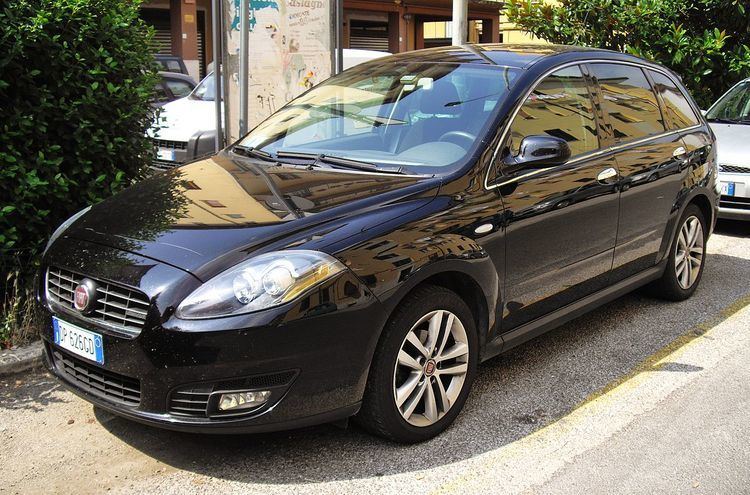Manufacturer Fiat Class Large family car | Production 1985–19962005–2011 | |
 | ||
Successor Fiat Marea (154)Fiat Freemont (194) | ||
Fiat Croma is the name used for two different large family cars produced by Italian automaker Fiat, one a 5-door liftback built from 1985 to 1996, and the other a cross-over station wagon built from 2005 to 2011.
Contents
First generation (1985–96)
The original Croma (Type 154) was a five-door notchback liftback penned by Giorgetto Giugiaro of Ital Design and built on the Type Four platform, which was designed in cooperation between several companies and was also used for the Saab 9000, Lancia Thema and Alfa Romeo 164. Although the other models were executive cars, the Croma was marketed in the large family car segment, replacing the Fiat Argenta in the Fiat lineup.
The Croma was the first large car produced by Fiat to feature a transverse-mounted engine and front wheel drive.
Facelift
The Croma received a light facelift for 1988, first shown in Frankfurt in September 1987. The black plastic between the rear lamps was now ridged rather than smooth, the lower portion of the bumpers were body-colored, and the turn signals received clear glass rather than amber. A more significant facelift in 1991 with new front design including changes to the lights, bumpers grille and sheet-metal changes to wings and bonnet. Also in 1991 the direct injected diesel engine was equipped with a variable geometry turbocharger ("VNT").
Production ceased in 1996, and Fiat abandoned the large family car segment. Because the Bravo/Brava-based Fiat Marea small family car débuted at the same time, it is sometimes said that the Marea replaced the Croma, but in fact Fiat never had a large family car after the Croma (until the resurrection in 2005), and Fiat eventually abandoned this segment of the worldwide market altogether.
Engines
The Croma was available with a variety of petrol and diesel engines, the former from the Fiat DOHC engine family. Base models had the 1585 cc, 83 PS (61 kW) and 1995 cc, 90 PS (66 kW) "Controlled High Turbulence" (CHT) powerplants, followed by two fuel injected 2.0 L units, one with 120 PS (88 kW) and the other a turbocharged and intercooled version giving 155 PS (114 kW). The later 2.5 L petrol V6 unit was from Alfa Romeo, but as with the 1.6 L engine, was not available in all markets. The 2.0 CHT was designed specifically to provide low fuel consumption under light and medium loads thanks to two separate inlet manifolds of different diameters.
The Fiat Croma was the first passenger car in the world to have a direct injection Diesel (Turbo D i.d.) engine, in 1986. Other diesel engines were the Fiat's 1.9 L fitted with a turbocharger with direct injection, giving 92 PS (68 kW), and the 2499 cc unit supplied by Iveco, with a normally aspirated version giving 75 PS (55 kW) and a turbocharged one with 115 PS (85 kW). This one replaced the original 2446 cc with 100 PS (74 kW). Diesel engined variants of this car were not marketed in the UK.
Second generation (2005–11)
In 2005, Fiat announced a large cross-over wagon with an upright tailgate, reminiscent of that of the Fiat Stilo, resurrecting the Croma nameplate. Again, Giugiaro styled the exterior, while the chassis was provided via the short-lived link with General Motors. The new Croma (Type 194) is therefore based on the extended variant of the GM Epsilon platform sharing components with the Opel Vectra and Saab 9-3. It went on sale in Italy in June 2005.
Unlike the previous model, and aware of its lack of image in the upper market segments, Fiat opted for not developing a standard large family car but developing a "Comfort Wagon", an automobile with design elements of both estates and large MPVs. Its height of 1,600 mm (63.0 in) falls between the Mitsubishi Grandis and Ford S-Max large MPVs (1,655 mm (65.2 in) and 1,660 mm (65.4 in) respectively) and SEAT Altea XL (1,525 mm (60.0 in)).
In February 2007, Fiat UK announced that the Croma would no longer be generally available in the United Kingdom, after less than 900 were sold in the whole of 2005. The car was still offered only on special order, with RHD models manufactured to customer specifications. Production of the second generation Croma stopped in early 2011. Despite not being a showroom hit, the Croma managed to sell in quite reasonable numbers, with 65,000 sold in one year alone.
Safety
The Croma has seven airbags as standard including knee bag for the driver. As standard the Croma is equipped with anti-lock braking system and electronic brakeforce distribution. It has a five-star EuroNCAP crash rating for adult occupant protection:
Facelift
The Croma got a minor facelift at the end of 2007 and was termed the Nuova Croma. A new grille (Bravo look) and rear bumper, as well as some material changes inside are the main differences. Fiat now designates the revised model as "Station Wagon" instead of the previously used term "Comfort Wagon". The Nuova Croma is only sold in mainland Europe.
Engines
The Croma, built at Fiat's Cassino factory, has three trim levels and five engine options. Like the chassis, petrol engines were supplied by Opel, beginning with the brand new evolution of the Family 1 Ecotec 1.8 L with 140 PS (103 kW), followed by the torquier L850 Ecotec 2.2 L with 147 PS (108 kW). However, the bulk of the sales is represented by Fiat's own Multijet engine, available in three variants 1.9 L with 8 valves and 120 PS (88 kW), 1.9 L with 16 valves and 150 PS (110 kW), and the range topper five-cylinder 2.4 L 20V, with 200 PS(147 kW). The Diesel engines are fitted with a standard six-speed manual gearbox, 6-speed automatic (standard on 2.4 engines) is also available.
